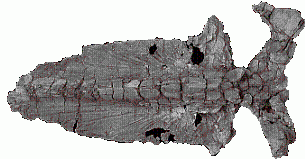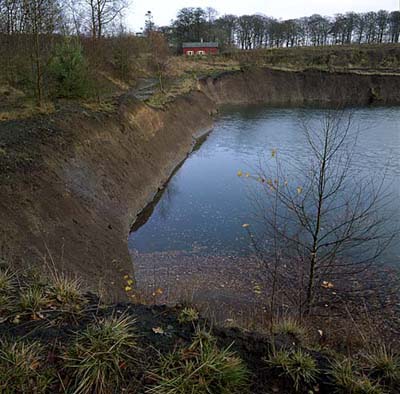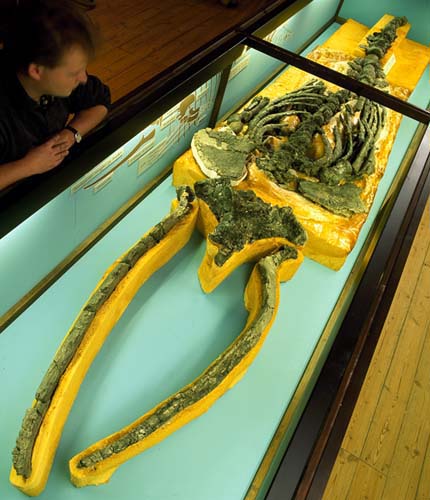Gram Lergrav
Theme: Macro vertebrates (whales) Locality: Gram claypit
Description of a Danish GeoSite

Photo: Cranium of baleen whale, by M. Abrahamsson
Primary identification
1. GeoSite no.:
GS - 6-1
2. National locality no.:
NGI - 100.
3. GeoSite name:
Gram Lergrav.
4. Location:
Denmark; Mid Southern Jutland.
5. Co-ordinates UTM:
System ED50 Zone 32, x=503784, y=6128476.
6. Type of locality:
Abandoned clay pit.
Primary geological features
7. Main topic:
Vertebrate and invertebrate fossils.
8. Geo(morpho)logy:
The large Gram clay pit is dug into the fat, rather homogeneous Upper Miocene micaceous clay of the Gram Formation at the type location for the Late Miocene Gram Stage. The Gram Clay is recognised within the North Sea region. The brownish clay is micaseous, grading more silty upwards, and weathering dark grey. The Gram Formation is capped by two thin beds of stormsand with wavelet ribs, signifying that the environment became gradually more coastal, albeit never less than 20 km. Concretions in the middle part of the formation, indicating that the general oxic conditions may occassionally have been interrupted by anoxia, contain fossil crabs. numerous fossils of bivalves, snails and crabs, as well as rather many vertebrates.
The exposed ca. 15 metres of the upper section of the Gram Clay in the pit containes a rather rich molluscan fauna - more than 100 species - in particular many snails, while the little bivalve Astarte reimersi (often bored by the moon shell Natica) is the most abundant. Also the bryozoan colony Cupuladria, shaped as a "chinese hat" in the cm scale, is rather common.
Among vertebrate remains ear stones (otolithes) from bony fish, a.o. codfish. Further shark teeth, among which the mako shark Isurus hastalis is well repressented, whereas there are rare specimens of the giant, triangular teeth of Megaselachus ("Carcharodon") megalodon, some of which are more than 15 cm heigh (corresponding to a fish with a length of about 12 m).
A large, rather peculiar shield of Psephophorus - an extinct far relative to the leatherback - has been found, as have bones of seals (a.o. penis bones) and birds.
Most famous are, however, the fossil whales - whales with teeth as well as baleen whales. One of the latter is described Mesocetus argillarius, a member of the group of primitive baleen whales, such as cetotherides. Skeletons of whales with teeth include specimens of sperm whales. All together rather many crania and some post cranial skeletons have been found.
The Gram Clay as a "burial-ground of whales" is interpreted as a deposit of a marine bay with moderately deep water, about 50-100 m, and the fauna as a whole is interpreted to also indicate fluctuations i salinity.
9. Frame / context:
Paleontology.
10. Chronostratigraphy:
Late Miocene.
11. Primary value:
Fossiliferous clay, whales.
12. Comparative evaluation:
Gram Claypit is the type locality of the Gram Stage within the North Sea. The comparative localities in Northern Germany and possibly Belgium are inaccessible.
13. Comparable GeoSites:
In Denmark: None.
Outside Denmark: Northern Germany and possibly Belgium.
Supplementary data in support of the locality
14. Delineation on a map:
15. Higth of the GeoSite:
15 metres (higth of maintained profile in pit).
16. Area of the GeoSite:
125.000 m2.
17. Subordinate geological interests:
Sedimentology, Stratigraphy.
18. "Non"-geo interests:
Education (fossil hunting).
Tourism.
19. References:
Bendix-Almgreen, 1983:
Gravesen 1993
Lindow, B., 2000: Gram Lergrav. Ekskursionsguide, 21 s. Geologisk Instituts Trykkeri, K�benhavn.
Rasmussen, L.B., 1966: Molluscan faunas and Biostratigraphy of thhe Marine Younger Miocene Formations in Denmark, Part I. Danm. Geol. Unders., II rk., 88, 358 p.
Rasmussen, L.B., 1966: Molluscan faunas and Biostratigraphy of thhe Marine Younger Miocene Formations in Denmark, Part I. Danm. Geol. Unders., II rk., 88, 358 p.
Rasmussen, E.S. og Larsen, O.H., 1989: Mineralogi og geokemi af det �vre Mioc�ne Gram Ler. Danm. Geol. Unders., Ser. D, Nr. 7, 81 s.
Roth, F., 1978:
Roth, F., 1983: Livet i Gram-havet. Nordslesvigske Museer 10, 10-28.
20. Data sources, collections:
Midts�nderjylland Museum at Gram castle has collections from the pit.
21. Illustrations:
 
Photos: Lake in the deeper part of the Gram claypit and preserved whale cranium from the exhibition, by Varna-Moors. See also photo at top of page.
22. Proposers:
Dansk Geologisk Forening & Det Kongelige Danske Geografiske Selskab/NN & Niels Bonde.
23. Description by:
Based on Gravesen, P., Jacobsen, P.R., Binderup, M. og Rasmussen, E.S., 2004: Geologisk set, Det sydlige Jylland. Danmarks og Gr�nlands Geologiske Unders�gelse, Skov- og Naturstyrelsen, Geografforlaget, 188 pp.
24. Recommandation:
Gram claypit is a GeoSite.
25. Comments:
Cross evaluation with analogue localities in Northern Germany should be performed.
26. Supplementary description:
...
|
[an error occurred while processing this directive]
List
Theme: Macro vertebrates (whales)
 |
